research
Ion Containing Polymer-Grafted Nanoparticles for Energy Applications
Conductivity in ionomer melts is governed by the density of conducting ions and ionic aggregation within low dielectric polymers. New material design strategies are essential to direct ion aggregation that will enhance ion conductivity within polymer composite films. We study the dispersion of ionomer-grafted magnetic nanoparticles (NPs) in polymers to explore their potential in energy applications. Anisotropic structures from polymer-grafted iron oxide (Fe3O4) NPs offer a promising route in controlling ionic aggregation and conductivity in ordered nanocomposites. We examine the interplay between ionic interactions and chain repulsion by varying the ion concentration and length of grafted chains. Transmission electron microscopy (TEM) and small-angle X-ray scattering (SAXS) results show that ion-containing polystyrene (PS)-grafted NPs form highly ordered chain-like structures below 3 mol% sulfonation in bulk at two particle loadings (5 and 15 wt%). Increasing grafted chain length leads to long-range spacing correlations between sulfonated strings. This facile strategy to create discrete and connected highly-ordered string nanostructures can be used as a means of controlling the ion aggregation and transport in polymer nanocomposites.
Multi-functional Particle Assemblies in Polymer Nanocomposites
We design multi-functional polymer composites displaying self-assembled nanostructures with tunable mechanical and conductive properties. This project aims to construct equilibrium magnetic nanostructures in which their multi-functional properties can be varied and optimized with the intermolecular forces. Polymer decorated iron oxide nanoparticles are a comprehensive model system offering both anisotropic and isotropic interactions that can be tuned with particle size, particle functionality (e.g. length and density of grafted chains, ions or bioligands) and external magnetic fields. We investigate the role of various interactions and elucidate the formation of thermodynamically equilibrium self-assembled structures through non-linear rheology, scattering and microscopy. We aim to study the fundamentals of the self-assembly mechanism for three-dimensional structures and their novel reversible self-assembly behavior.

highly-ordered strings of PS-grafted nanoparticles in bulk phase. Scale bar: 100 nm.


Structure factors (from SAXS) of sulfonated PS-tethered nanoparticles with 0.5-3 mol% sulfonation levels.
Instruments in Soft Materials Lab:
TA Instruments’ ARES-G2 strain-controlled rheometer
Bruker Optics’ FTIR-ATR
Wyatt Technology’s GPC-LS
Laurell Spin-coater
Polymer Nanocomposites under Large Deformation
We explore deformation of homopolymers and nanocomposites under large stresses. We examine the reversibility of nanostructures exposed to large strains which is critical for high-strength materials. We also investigate the origins of mechanical properties by tuning particle-polymer interphases under modulated shear deformations. By taking advantage of large-amplitude oscillatory deformations, chains can be desorbed/readsorbed, leading to interesting self-stiffening behavior. This concept is explored for bimodal chains adsorbed on nanoparticles to reveal the effect of interphases on fragility and mechanical properties of polymer nanocomposites. Such dynamic interphases is critically important in designing systems with modulated stiffness and tunable mechanical properties.
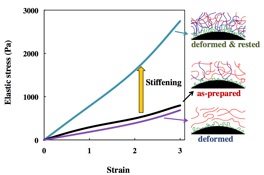


Funding:
We gratefully acknowledge our funding sources.

Ordering pH-Responsive Polyelectrolyte Grafted Nanoparticles in a Flow-Coating Process
Deposition of nanoparticles during evaporation depends on several factors such as substrate hydrophilicity, evaporation rate, particle-particle and particle-polymer interactions. In this project, we demonstrate a template-free method to fabricate patterned thin films by controlling the particle interactions through varying grafting parameters. Repulsive and attractive interactions between grafted particles, the pH dependent properties of polymer and hydrogen bonding between grafted and free polymer chains are all utilized to create various intriguing patterns of films from deposition of nanoparticles: Randomly distributed dots, polygonal networks, meshes, fork‐like structures along with highly regulated and densely packed stripes parallel to the moving direction of substrates are fabricated. Our next goal is to fabricate conductive composite films with the use of anisotropic particles.


Self-Assembly of Polyelectrolyte Grafted Nanoparticles in Solution
This project unravels the role of the ionic interactions and chain-chain entanglements between polyelectrolyte-grafted nanoparticles on the rheological properties of their colloidal solutions. Nanoparticles grafted with poly(acrylic acid) (PAA) chains with different grafting densities and similar graft chain lengths at semi-dilute concentrations are investigated using small-angle neutron scattering (SANS) and rheology experiments. The changes in viscosity of grafted particle solutions were found to depend on the conformational interactions between particles, a parameter determined by the grafting density of SiO2-PAA particles and pH. The viscosity adjustment with the addition of short polymer linkers suggested that intra-particle bonding was possible at low graft density, whereas networking between inter-particles occurred with the high graft density. This fundamental study provides a good insight on how polymer grafted particles interact and influence the flow properties of particle suspensions, which has direct ramifications on solution processing of polyelectrolyte particles for thin film device applications.
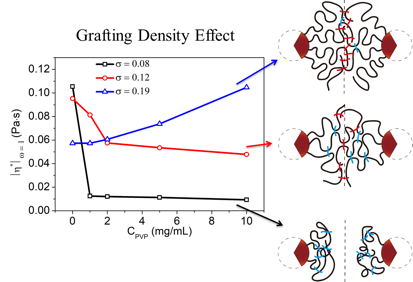
Bioengineered Surfaces of Varying Hydrophilicity
Understanding of the adhesive nature of a surface is of fundamental importance when designing devices for in vivo biomedical use. Non-specific protein adhesion, which occurs when a synthetic material is exposed to a biological fluid, can trigger a variety of undesirable effects such as inflammation and implant failure. Roughness, hydrophobicity, and elastic modulus of the exposed surface all influence the extent to which repulsion or attraction between two contacting materials will occur. Therefore, it is critical to understand how these properties will affect protein adhesion when designing any biocompatible surface. Designs of systems to prevent non-specific adsorption typically involve coating surfaces with either polymeric films, consisting of one or more polymeric species, or biological molecules such that they are non-conducive to non-specific adsorption. Our purpose is to control the density, coverage of hydrophilic patches to understand protein adhesion on these surfaces that can be used for applications in therapeutics and clinical diagnosis.

Ordered nanostructured surfaces can be used to mimic the in vivo confined environment to understand protein structure, function and elasticity. Elastic moduli maps present the elasticity of fibrinogen-functionalized nanopores and protein density.
Reversible Thermal-Stiffening in Polymer Nanocomposites
We showed that linear, amorphous, and weakly interacting polymer blends in the presence of nanoparticles reversibly stiffen at high temperatures due to differences in chain relaxations between adsorbed and matrix polymers occurring at dynamically asymmetric nanoparticle interfaces. This remarkable and unusual behavior of polymer nanocomposites can be used for high temperature applications where mechanical integrity is critical for the performance of hybrid materials. We design, synthesize, and develop mechanically adaptive polymer nanocomposites that can perform at high temperatures and under large shear stresses. The specific hypothesis is that chemical and dynamic heterogeneities of miscible blends can give rise to unexpected reinforcement when coupled with nanofillers. Polymer architectures and structures near or on the surface of nanofillers and the miscibility of matrix polymers with these structured topologies determine the complex dynamics of chains in confined interfaces. Chain dynamics coupled with various chain architectures are being utilized to determine the origin of reinforcement and interfacially controlled mechanical properties.


biosensors
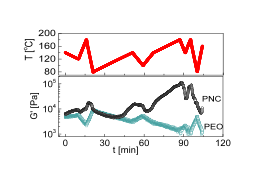
Soft Materials Laboratory
Ionic Transport in Ion Containing Copolymer-Grafted Nanoparticle Structures
We investigate novel ion-containing copolymer-grafted nanoparticle system to explore the role of ionic interactions and solvent-polymer interactions on the structure and dynamics of assembled structures. Polymer-grafted particle-based assembled nanostructures are used to control ion aggregation and the physical confinement of ionic liquids. Low water uptake, particle structure controlled conductivity and mechanical stability of two-dimensional structures and networks are the unique features of designed charged polymer-grafted systems. Creating two- and three-dimensional structures from copolymer-decorated particles will transform these hybrid materials into effective nanostructured ion gels for their uses in electrochemical devices.
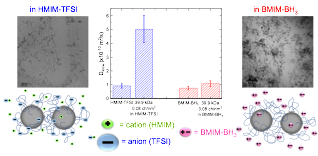
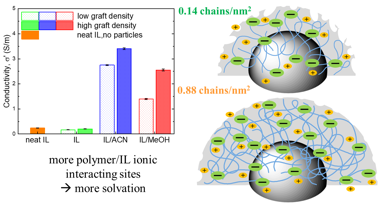
Ion-dipole Interactions between ionic liquid and polymer are shown to influence the solvation and conductive properties in ionic liquid-based hybrid electrolytes. The cover art shows that the higher grafting density of polymers that are swollen in good solvent (acetonitrile, ACN) promotes better solvation and conductivity of ionic liquids.
Polymer coupling with HMIM-TFSI influences the long-range diffusion coefficient (Dslow) of HMIM+ cations.
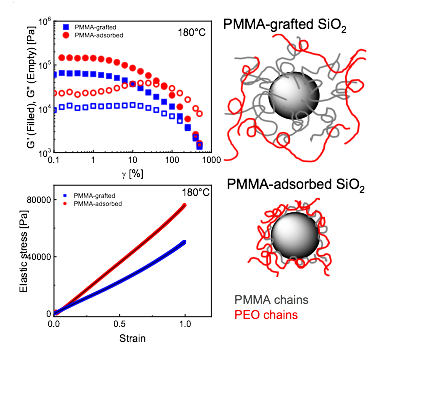
© 2018. Stevens Institute of Technology. All rights reserved. Castle Point on Hudson, Hoboken, NJ 07030 USA